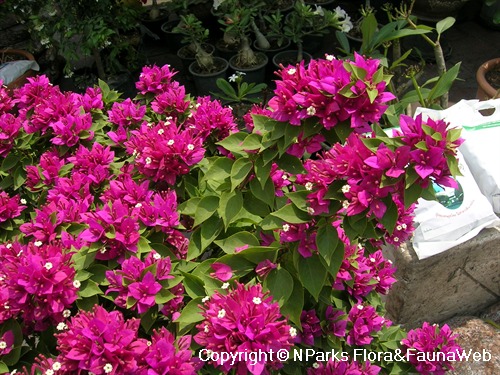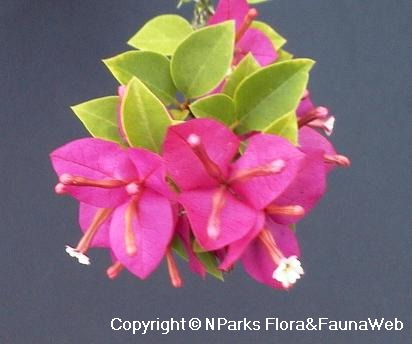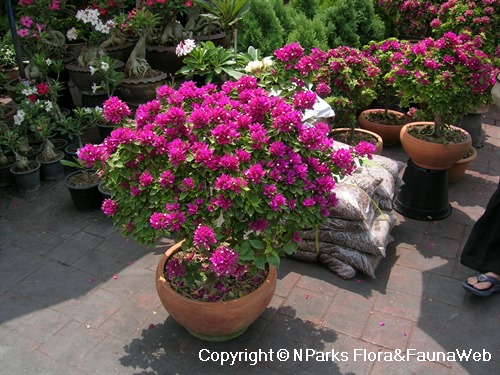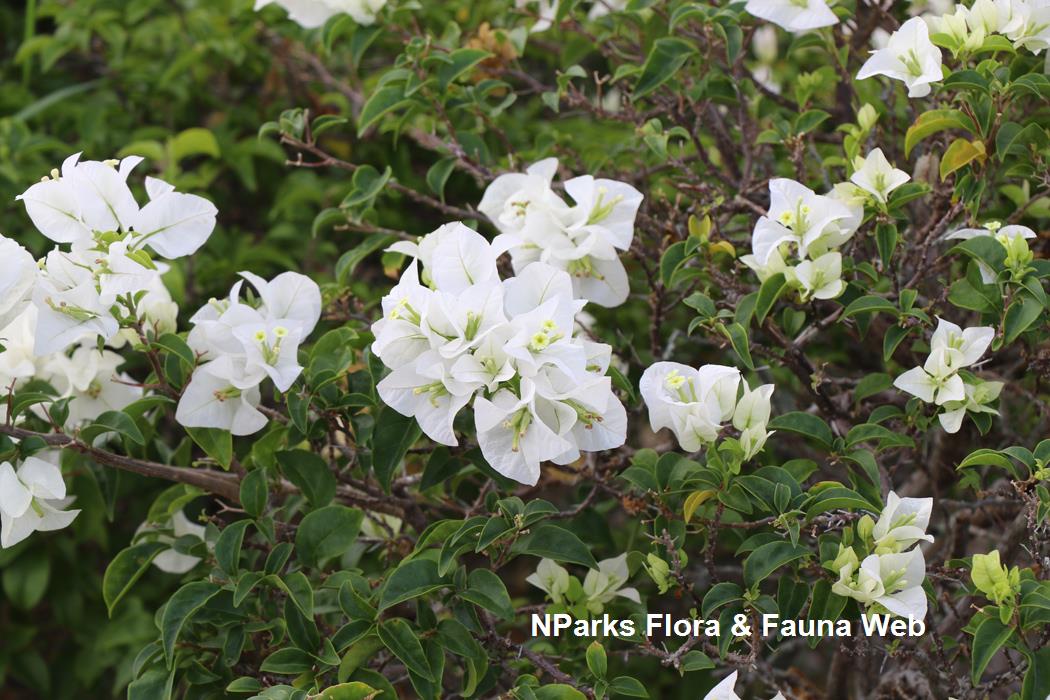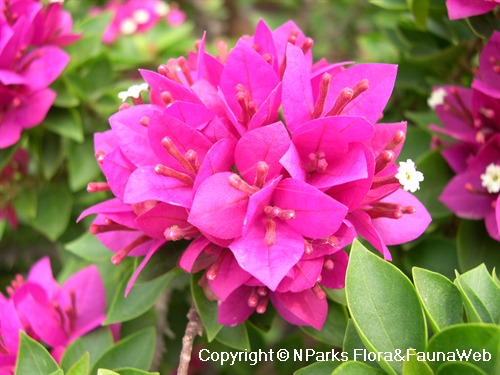
Back
Bougainvillea 'Torch Glow'
| Family Name: | Nyctaginaceae |
| Synonyms: | Bougainvillea 'Lord Willingdon' (misapplied), Bougainvillea 'Smartie Pants', Bougainvillea 'Mini Thai', Bougainvillea 'Pixie', Bougainvillea 'Smarty Pants', Bougainvillea 'Smartipants' |
Name
Classifications and Characteristics
| Plant Division | Angiosperms (Flowering Seed Plants) (Dicotyledon) |
|---|---|
| Plant Growth Form | Shrub |
| Lifespan (in Singapore) | Perennial |
| Mode of Nutrition | Autotrophic |
| Plant Shape | Compact |
| Maximum Height | 1.2 m to 2 m |
| Maximum Plant Spread / Crown Width | 1.2 m to 1.5 m |
Description and Ethnobotany
| Growth Form | Woody shrub with predominantly upright branching, up to 2m tall when planted in ground. Compact, non-climbing, non-sprawling. Root system more succulent than typical. Distinctly unlike other regular Bougainvilleas. |
|---|---|
| Stems | Slender, upright, growing to 1m in length. Young stems purplish green, covered with very short upward-curving hairs. Older branches greyish-brown, splittling lengthwise to reveal green layer beneath. Relatively spine-free, older stems may have twig-like rudimentary spines that are not sharp. |
| Fruit | None observed so far. |
| Others - Plant Morphology | Cultivar Info: Asexual mutation (patened: 1986) of unknown parentage discovered by commercial growers Ingwersen & Tomlinson amongst some cuttings in their Californian nursery. Foliage: Leaves green, somewhat fleshy, densely produced near stem apex.Flowers & Bracts: Flowers white, tubular, petal-less, small and inconspicuous, produced in cyme inflorescences, with each inflorescence bearing 3 flowers subtended by showy purplish-red papery bracts (petal-like modifiied leaves). Spike-like inflorescences densely produced in axils of almost all leaves along the stem from tip down to 10-40cm below, thus resembling cylindrical floral torches. Free-blooming year-round. |
| Cultivation | Hardy and drought-tolerant. Prefers well-drained soil. Needs only occasional watering once established, avoid overwatering. Blooms better when drought-stressed and root-bound. Tolerates hard-pruning, but tends to retain its naturally-compact form, even with infrequent pruning. Due to its more succulent and fragile root system, plant does not take transplanting well, exercise caution to maintain an intact rootball when moving plant. Propagate by stem cuttings. |
| Etymology | Genus epithet 'Bougainvillea' named in honour of celebrated admiral-cum-explorer Louis Antoine de Bougainville (1729-1811), who in the mid 18th century became the first Frenchman to cross the Pacific Ocean and circumnavigate the globe. His crew found the colourful South American plants during a stop at Soloman Islands and named them after him. |
Landscaping Features
| Desirable Plant Features | Ornamental Flowers |
|---|---|
| Landscape Uses | Container Planting, General, Flowerbed / Border, Hedge / Screening, Focal Plant |
| Thematic Landscaping | Naturalistic Garden |
Plant Care and Propagation
| Light Preference | Full Sun |
|---|---|
| Water Preference | Little Water |
| Plant Growth Rate | Moderate |
| Rootzone Tolerance | Easy to Grow, Drought Tolerant, Well-Drained Soils, Poor Infertile Soils |
| Maintenance Requirements | Moderate |
| Propagation Method | Stem Cutting |
Foliar
| Foliage Retention | Evergreen |
|---|---|
| Mature Foliage Colour(s) | Green |
| Mature Foliage Texture(s) | Smooth, Thick |
| Foliar Type | Simple / Unifoliate |
| Foliar Venation | Pinnate / Net |
| Foliar Margin | Entire |
| Leaf Area Index (LAI) for Green Plot Ratio | 4.5 (Shrub & Groundcover - Dicot) |
Non - Foliar and Storage
| Stem Type & Modification | Woody |
|---|---|
| Root Type | Underground (Tap Root, Fibrous Root) |
| Specialised Storage Organ(s) | Aboveground |
Floral (Angiosperm)
| Flower & Plant Sexuality | Bisexual Flowers |
| Flower Colour(s) | Pink, Purple |
|---|---|
| Individual Flower Shape | Tubular |
| Inflorescence Type | Cyme |
| Flowering Period | Free-Flowering |
| Flowering Habit | Polycarpic |
Image Repository
Others
| Master ID | 57 |
|---|---|
| Species ID | 1353 |
| Flora Disclaimer | The information in this website has been compiled from reliable sources, such as reference works on medicinal plants. It is not a substitute for medical advice or treatment and NParks does not purport to provide any medical advice. Readers should always consult his/her physician before using or consuming a plant for medicinal purposes. |


